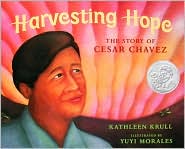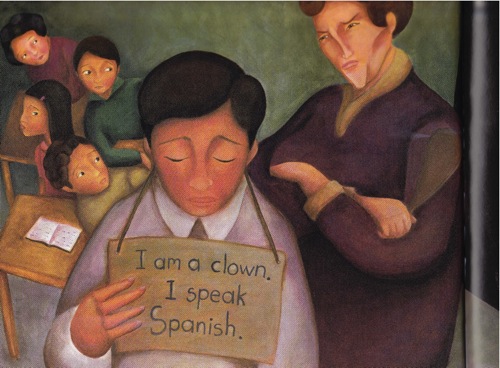by Mary Starrs Armstrong, University of Alaska, Anchorage, AK
 This month I invite you to explore biographies, focusing on personal response and extensions to culture. In what ways can reading biographies, thinking and writing and talking about them inform us about ourselves as well as other cultures?
This month I invite you to explore biographies, focusing on personal response and extensions to culture. In what ways can reading biographies, thinking and writing and talking about them inform us about ourselves as well as other cultures?
Biographies and autobiography have the unique ability to reach into the soil of human experience and till it for the reader (Duthie, 1998) as well as provide a springboard for thought and argument, inquiry and pleasure (Harvey 2002).
Through reading and responding to Harvesting Hope (Krull 2003), Mario made personal connections that evoked memories keeping him focused, interested while expanding his world.
Mario was a Mexican American fifth grader whose first language is Spanish. He quickly found parallels to events in the early life of Cesar Chavez to a few poignant experiences of his own. He told me:
“I was interested [in Cesar Chavez] because he helped Mexican people and he was American, too. It was bringing lots of memories back for me. That’s why I chose it. Well, first he didn’t know English. Neither did I. He was made fun of; kids made fun of me. Sometimes I cried because of that…I had a hard life, too, just like him…it made me mad a lot that he wasn’t allowed to speak Spanish.”
Later on, Mario’s voice wavered and he appeared near tears when he shared his initial response to Harvesting Hope with the entire class showing the full page illustration of Cesar Chavez as a school boy, wearing a sign that read, “I am a clown, I speak Spanish.”
During our biography study Mario entered in his notebook:
“How I feel about Cesar Chavez is that I feel sorry for him because he got beat up and what I didn’t like about his teacher she put something on him that said he was a clown because he spoke Spanish! That’s not right! What I don’t like about those times is that they made fun of Mexican people.”
Mario’s writing assessment, a personal narrative describing his move from one Western state to another, indicated further that his connection to the life of Chavez was not isolated:
One month later we moved. I was very nervous because I was going to my new school…I was in first grade. The principal was taking me to my classroom. And do you know what? I didn’t know any English…That’s when I met my best buddy. He translated for me. My teacher…was…mean…as a demon. She yelled at me very loud and sometimes I got scared. The kids didn’t like me very much because I didn’t know any English. That reminds me about Cesar Chavez. I was going through the same thing he did because we were made fun of because we didn’t speak English.
Mario “till[ed] the soil of human experience” during and after reading Harvesting Hope.
* Which biographies are available to your students and which do your students choose?
* In what ways do your students connect and respond to biography?
* How does biography enrich cultural knowledge, understanding or personal experience?
Duthie, C. (1998) “It’s just plain real”: Introducing young children to biography and autobiography. The New Advocate. 11(3) 219-227.
Harvey, S. (2002) Nonfiction inquiry: Using read reading and writing to explore the world. Language Arts. 80(1) 12-22
Krull, K. (2003) Harvesting Hope. New York: Harcourt.
Please visit wowlit.org to browse or search our growing database of books, to read one of our two on-line journals, or to learn more about our mission.
- Themes: Harvesting Hope, Kathleen Krull, Mary Starrs Armstrong, Yuyi Morales
- Descriptors: Books & Resources, Student Connections, WOW Currents


Well from a personal standpoint, I was addicted to the Bobbs Merril biography series. As a child I wanted to know more about the people who had gone before me. Perhaps this was because my father is an historian and a storyteller who blended historical issues with story at our dinner table. The implications for this are that when a teacher has a passion for sharing the past (or present) and when the resources are there, children will follow the lead. I think children have a yearning to know about other people and the more diversity we can provide in choice the broader the range.
I agree, Barbara!
A teacher’s passion, interest as well as persistence can converge to make pathways for readers and writers to explore others’ lives. Having good materials is critical, yes. Good news is there are oh! so many well done, finely researched and beautifully illustrated biographies available for children and young adults these days that our reasons not to explore this rich genre evaporate. M*A